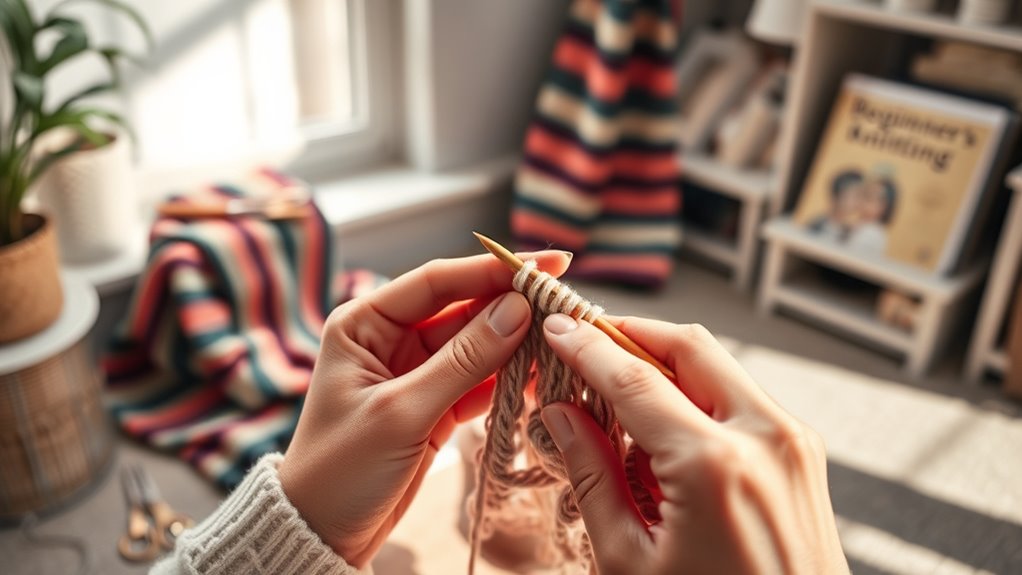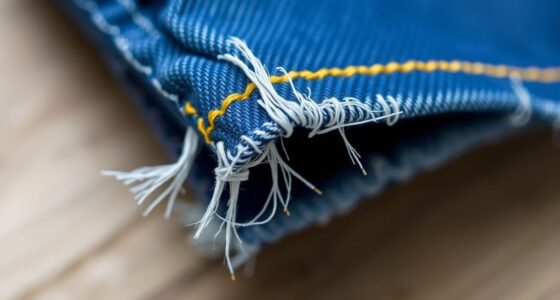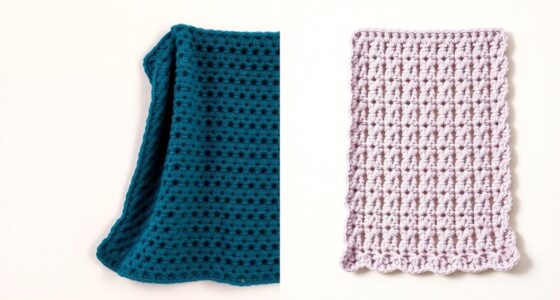To get started, hold your circular needles comfortably and use the long-tail cast on method to create your foundation stitches, keeping tension even. To knit, insert the right needle into a stitch from left to right, wrap your yarn counterclockwise, and pull through. For purling, insert the needle from right to left and wrap clockwise. Practice these techniques to build your skills—if you keep going, you’ll soon master more essential stitches and patterns.
Key Takeaways
- Use circular needles for versatility and comfort when casting on, knitting, and purling larger projects.
- To cast on, create loops around the needle using a long-tail method for a sturdy edge.
- Knit stitches produce a smooth V-pattern; insert the right needle from left to right, wrap yarn, and pull through.
- Purl stitches create a bumpy texture; insert the needle from right to left, wrap yarn clockwise, and pull through.
- Cast off by knitting two stitches, lifting the first over the second, then pulling yarn through to secure the edge.

Have you ever wanted to create your own cozy scarves or colorful blankets? Knitting offers a relaxing and rewarding way to craft personalized pieces. To get started, you’ll need to learn some basic techniques, beginning with how to cast on stitches. If you’re using circular needles, don’t worry—these are perfect for both small projects and larger items like blankets because they hold more stitches comfortably and allow you to knit in the round or flat. When casting on, hold your needle in your dominant hand, and use your other hand to create loops around the needle, following a simple method like the long-tail cast on for a sturdy edge. This method produces a neat, flexible start, perfect for your first projects. As you cast on, keep your tension even so your fabric remains consistent. Additionally, understanding your tools and materials, such as circular needles, can make your knitting experience more enjoyable and versatile.
Once you’ve cast on enough stitches, you’re ready to start knitting. The basic knit stitch creates a smooth, V-shaped pattern on the fabric’s front. To knit, insert your right needle into the front of the first stitch on your left needle from left to right, then wrap the working yarn around your right needle counterclockwise. Pull the yarn through, and slip the old stitch off the left needle. Repeat this process across the row. Practice until you feel comfortable maintaining a steady rhythm. Purl stitches are just as essential—they create a bumpy texture on the front side and are used for ribbing and shaping. To purl, insert your right needle into the front of the next stitch from right to left, wrap the yarn around the needle clockwise, then pull through and slip the old stitch off. Alternating knit and purl stitches allows you to create textured patterns and edges that give your projects a professional look.
When you’re finished with your project, you’ll need to cast off, or bind off, the stitches to secure the work and prevent unraveling. To cast off, knit the first two stitches, then use your left needle to lift the first stitch over the second and off the needle. Continue knitting one stitch and lifting the previous stitch over it until only one stitch remains. Cut the yarn, leaving a tail, and pull it through the last stitch to secure. This technique guarantees a snug, even edge. With practice, you’ll find casting off is straightforward and essential for finishing your items neatly. Whether you’re making a scarf, blanket, or hat, mastering casting off with circular needles and understanding how to manage your stitches will help you create polished, lasting pieces that you’ll be proud to wear or gift.
Frequently Asked Questions
What Types of Yarn Are Best for Beginners?
For beginners, the best yarns are medium weight, like worsted or aran, because they’re easy to handle and see your stitches clearly. Stick to soft fiber types like acrylic, wool blends, or cotton, which are comfortable and forgiving. These yarns provide good stitch definition and are less likely to split, making your knitting experience smoother and more enjoyable as you learn the basics.
How Do I Fix Common Knitting Mistakes?
Think of fixing mistakes as untangling a knot in your yarn garden. To correct yarn tension issues, gently adjust your stitches, pulling or loosening as needed. For fixing dropped stitches, use a crochet hook to catch the loose loop and carefully work it back up the needle. Stay patient and steady—these small fixes help keep your project tidy and enjoyable, turning mistakes into learning moments.
What Are the Essential Knitting Tools Needed?
You need a good set of knitting needles, preferably in different sizes, to match your projects. Yarn selection is essential—choose soft, suitable yarn for your project’s purpose. Keep a variety of yarn weights and textures handy. Having scissors, stitch markers, and a tapestry needle also helps. These tools make knitting easier, help you fix mistakes, and give your projects a polished finish.
How Do I Read a Knitting Pattern?
To read a knitting pattern, start by understanding pattern abbreviations like k for knit and p for purl. Then, familiarize yourself with reading chart symbols, which visually represent stitches. Pay attention to the pattern’s key or legend, which explains each symbol. Follow the instructions step-by-step, keeping the abbreviations and symbols in mind, and you’ll smoothly navigate your pattern to create beautiful knitting projects.
How Can I Create Different Knitting Textures?
You can create different knitting textures by exploring cable patterns, textured stitches, and combining various techniques. Experiment with crossing stitches to form cables, adding bobbles or popcorn stitches for dimension, and using seed or moss stitches for a bumpy surface. These methods evoke interest, depth, and personality in your projects. Embrace the variety of textures, and let your creativity flow through each stitch, making your knitting uniquely mesmerizing.
Conclusion
Now that you know how to cast on, knit, and purl, you’re ready to start your knitting journey. Don’t worry if your first projects aren’t perfect—practice makes perfect! The more you knit, the more confident you’ll become. Remember, knitting is about enjoying the process, not just the finished product. Keep your stitches relaxed and have fun creating something beautiful with your own hands. Happy knitting!









